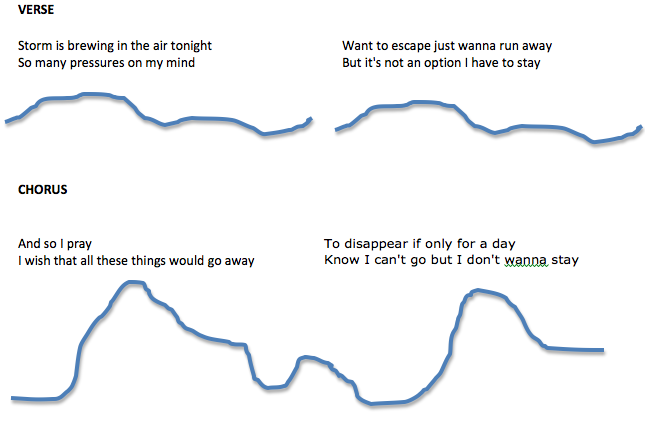“The Essential Secrets of Songwriting” 6 e-Book Bundle is being used by thousands of songwriters to solve their songwriting dilemmas. Comes with a 7th free eBook, “From Amateur to Ace: Writing Songs Like a Pro.” Read More..
______________
 When you look at the construction of melodies from the past six decades of pop music, you see a common trait: verse melodies often tend to have a rambling, wandering quality, and then things tighten up and become a lot more repetitive and hooky for the chorus.
When you look at the construction of melodies from the past six decades of pop music, you see a common trait: verse melodies often tend to have a rambling, wandering quality, and then things tighten up and become a lot more repetitive and hooky for the chorus.
It’s not always like that, though, and that’s because music can never be quite that predictable. There’s a beautiful little tune by Welsh singer-songwriter Jem (Jemma Griffiths), “And So I Pray,” (co-written by Jem, Viginia Astley and Kevin Beber) that shows the attractive quality that can come from a verse melody that’s somewhat static, and then switching to a chorus that’s suddenly liberated and expressive.
Give the song a few listens; it’s quite short, and its uncomplicated structure makes it a wonderful model for musical simplicity. You’ll find that melody and lyric work together expertly. The lyric describes a situation (love gone wrong?) that for the moment has no good solution.
With this kind of song topic, you’ll often find that avoiding the tonic note in the melody has a particularly powerful effect of making the music feel unsettled. Throughout the entire song, the tonic note only ever appears on a weak beat (i.e., not beat 1 of a bar), or partnered with a non-tonic chord.
But I think the real charm of this song is in comparing the structure of the verse melody with that of the chorus, and how those different melodies enhance the lyric. Even if you don’t read music, just looking at a line drawing approximating the scope of the melodies shows you the contrasting melodic design:
For the verse, the singer feels depressed, practically immobilized by a simmering, negative situation. That’s reinforced by the kind of melody we find attached to the words: dwelling on single pitches, encompassing only a 4th.
In the chorus, the singer imagines all of her worries lifting, all her anxieties flying off and leaving her alone. To express it musically, the melody takes flight, moving up and down, covering a full octave within only two bars of music.
A lot of this kind of thing happens on an instinctive level, but students of songwriting need to be aware of the immense power that can come from purposely partnering melody and lyric in this way. A good melody will not only act as a vehicle for your song’s text; it can fully imprint the more important subtextual meaning of what you’re trying to convey.
Try this as an experiment with your latest song: sing through the song, and think about what the shape of your melody is doing either to enhance or inhibit the meaning of your lyric. You may find that just one or two adjustments will go a long way to intensifying that all-important relationship, making a stronger connection to your audience.
______________
 Written by Gary Ewer. Follow on Twitter.
Written by Gary Ewer. Follow on Twitter.
“The Essential Secrets of Songwriting” 6-eBook Bundle looks at songwriting from every angle, and has been used by thousands of songwriters. How to use chords, write melodies, and craft winning lyrics. $95.70 $37.00 (and you’ll receive a FREE copy of “From Amateur to Ace: Writing Songs Like a Pro.“)










